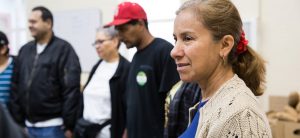Seventy-six-year-old breast cancer survivor Barbara Johnson is one of the 350 participants who visit the Casa de Barro Church Food Bank pantry each week in San Francisco. She ambles in and is greeted by smiles, laughs, and warm welcomes from all the pantry volunteers.
Barbara worked almost her whole life doing clerical work and then as a medical assistant. Now retired, her income is less than $800 per month. Without the Food Bank, she said she would be going hungry.
“There are so many fresh fruits and vegetables here that I couldn’t afford otherwise,” said Barbara. “And the volunteers are so nice and treat us with respect.”
Barbara especially loves the oranges, peaches, and grapes. One of her favorite vegetable recipes is to use Food Bank corn and canned tomatoes and add some store-bought sausage to make a succotash. Over the holidays, Barbara makes candied yams and baked chicken with the ingredients she gets at the pantry.
“It really helps me stretch my budget at the holidays because there’s more family to feed,” said Barbara who has her brother, daughter, nieces, and nephews over. But she misses her son who died of a heart attack at age 52.
Barbara says one of the best things about the Food Bank pantry is that there’s a sense of community. People check in about each other’s lives, whether someone’s facing an illness like breast cancer, or there’s a death in the family.
“Whether it’s here at the church, or if you see people on the street, the pantry folks are friendly and ask how you are doing,” said Barbara. “It’s not about handouts, it’s about being together.”
Casa de Barro in San Francisco’s Outer Mission neighborhood is one of more than 250 weekly pantries in our region where the Food Bank distributes healthy groceries to neighbors in need.




Share